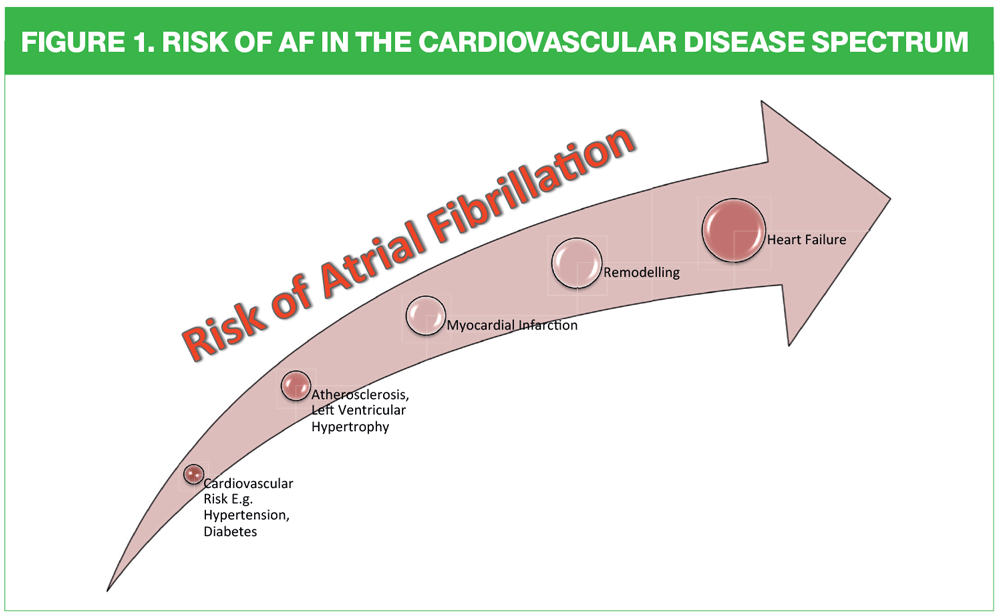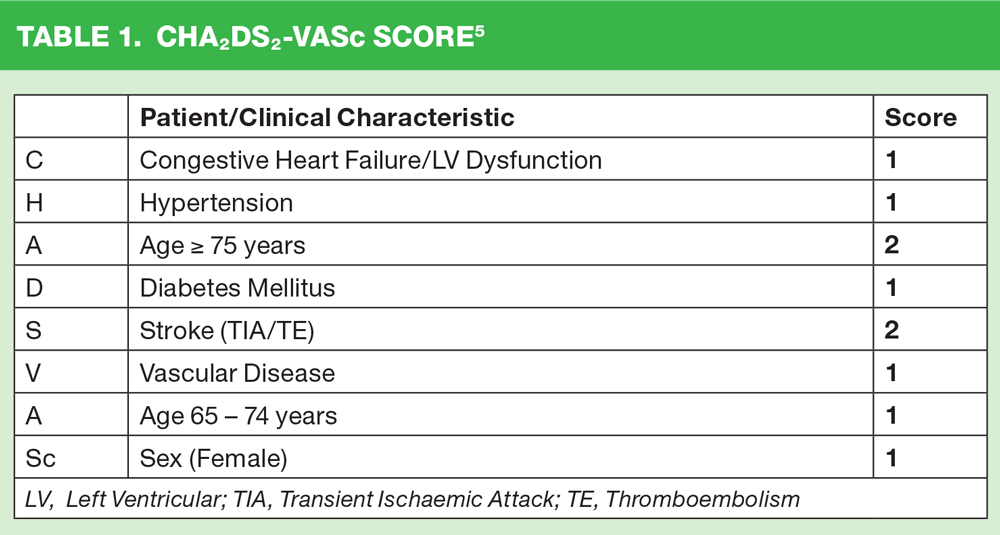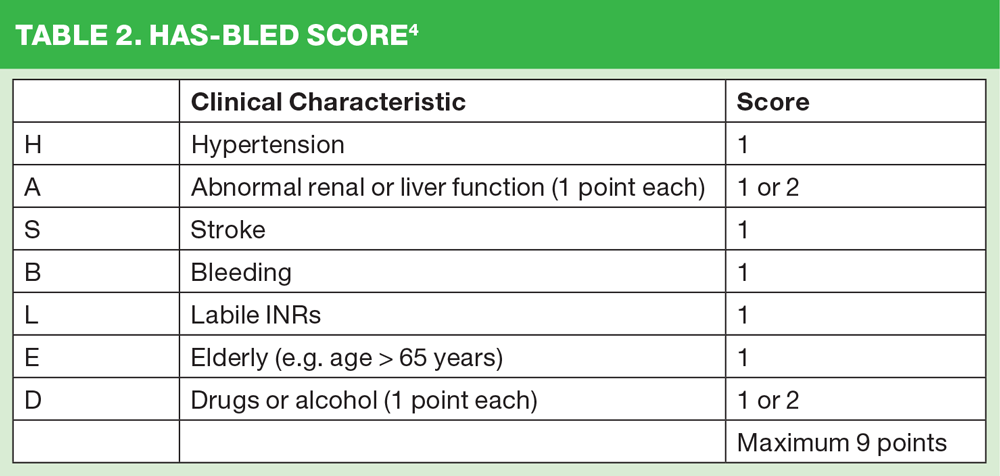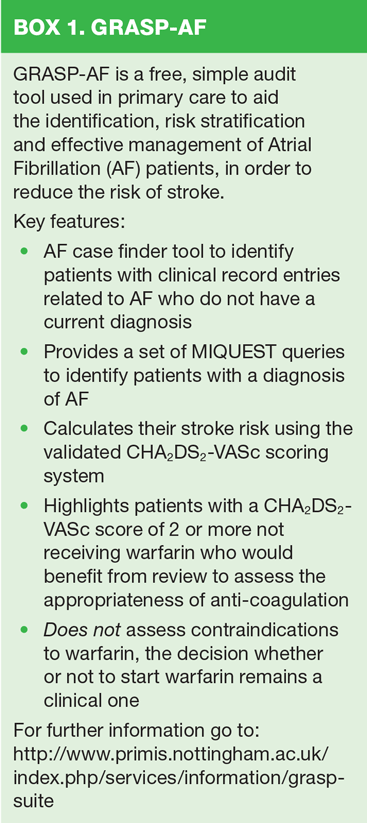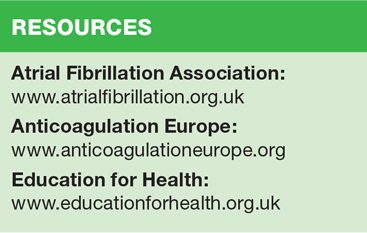Anticoagulation in atrial fibrillation: where are we now?
Joanne M. Loades
Joanne M. Loades
RN MSc
Independent Nurse Consultant in Cardiovascular Disease
Clinical Trainer, Education for Health
Atrial fibrillation is the most common sustained cardiac arrhythmia and carries a five-fold increased risk of stroke. Nine out of ten people with atrial fibrillation would benefit from anticoagulation therapies yet there is often reticence and barriers to their use, from patients, clinicians and some primary care organisations
The drive to improve rates of anticoagulation in people with atrial fibrillation (AF) has been high on the agenda of many primary care organisations across the country. Initiatives relating to the detection and management of AF, including the NHS Improvement tool ‘GRASP-AF’, have been implemented nationally, regionally and locally as part of admission avoidance, health promotion and prescribing schemes. So, where are we now with anticoagulation in AF?
Finding the patients is the first part of the story, but does effective treatment always follow on from detection? Reticence in anticoagulation appears to be a multi-factorial issue and is not helped by conflicting reports in the medical press on the treatment options available. For example, earlier this year media attention turned to an anomaly within one of the Novel Oral Anticoagulant (NOAC) clinical trials relating to its INR monitoring assay, therefore questioning its validity. Although this was rapidly investigated and shown not to have had a significant impact on study outcomes, such stories can still cast doubt on the evidence and, along with other factors such as prescribing restrictions, can negatively impact patients’ access to effective treatments.
A RECAP: WHY IT IS IMPORTANT
AF is the most common, sustained cardiac arrhythmia and, if left untreated, is a significant risk factor for stroke and other morbidities. AF affects around 2% of the population in the UK, its prevalence rising rapidly with age and in the presence of cardiovascular disease or increased risk factors such as hypertension. At the end of the cardiovascular spectrum, up to one third of individuals with heart failure will also be affected by AF, with an apparent linear relationship between symptoms and function measured on the New York Heart Association (NYHA) scale and the presence of AF.1 (Figure 1)
In AF the fibrillating atria are susceptible to the formation of thrombi that may embolise, usually from within the left atrium and specifically the left atrial appendage, and enter the circulatory system. Anatomically the most convenient and common route for a thromboembolism to take from the left atrium is through the carotid arteries to the mid brain, with potentially catastrophic consequences for the patient. The risk of stroke is increased five-fold in those with AF and these are often very severe and disabling events with survivors much more likely to suffer long-term functional problems and be unable to return to work and ‘normal’ life. 2
WEIGHING UP THE RISKS
To ensure the optimum risk-benefit balance in treatment decision-making clinicians perform stroke risk assessment using the evidence based CHA2DS2-VASc score (Table 1) . This is an extension to the former CHADS2 Score that incorporates further risk factors influencing stroke risk, including previous thromboembolic events and gender. With the tool embedded in practice clinical systems it is easily accessible within the consultation and takes little time to complete.
The evidence behind CHA2DS2-VASc shows that only around 1 in 10 people with AF do NOT have a significant enough stroke risk to warrant anticoagulation. These are generally males below the age of 65 with no other risk factors.3 This means that the vast majority of the individuals on the practice AF register will have a score of ≥1 and will be a candidate for anticoagulation unless contraindicated.
What about bleeding?
Alongside assessing stroke risk it is essential to consider the individual’s risk of bleeding, since this is the main risk of anticoagulation and causes great concern to clinicians and patients alike.
HAS-BLED is a scoring system used to assess 1-year risk of major bleeding in patients with atrial fibrillation (Table 2).4 It was developed in 2010 with data from 3,978 patients in the Euro Heart Survey and can be used alongside CHA2DS2-VASc to evaluate bleeding risk through common factors.5 Experts, including NICE, stipulate that a HAS-BLED score of ≥3, though indicating higher risk, should not be used on its own to exclude patients from anticoagulation. Its use does, however, allow the clinician to identify bleeding risk factors and to correct those that are modifiable, including control of blood pressure and removal of concomitant antiplatelet or non-steroidal anti-inflammatory drugs.3
CURRENT TREATMENT OPTIONS
There have been significant advances in recent years in the range of treatments available for anticoagulation in patients with AF. The introduction of the first ‘Novel Oral Anticoagulant’ (NOAC) to market in 2011 marked the beginning of a new era in oral anticoagulation, for patients and clinicians alike, though responses were varied, and continue to be so today.
Warfarin
The vitamin K antagonist, warfarin, is the most commonly prescribed anticoagulant in the world. Its discovery dates back to the prairies of North America in the 1920s, where many cattle died of haemorrhage linked to their ‘sweet clover hay’ diet. In 1945 the idea of using a derivative of coumarin, the active substance in sweet clover, as a rodenticide was developed. Thus begins the story of warfarin, still referred to as ‘rat poison’ by patients, and some clinicians, today.6
Warfarin remains a clinically and cost effective treatment choice for patients with AF and remains the only choice for patients with valvular AF. Its use, however, is burdened by the need for regular INR monitoring and the presence of many drug and food interactions.
NOVEL ORAL ANTICOAGULANTS
There are currently four NOACs licensed for use for stroke prevention in non-valvular AF in the UK.
Dabigatran is a direct thrombin inhibitor that acts on the coagulation cascade by inhibiting the action of the enzyme thrombin in its role of converting soluble fibrinogen to the non-soluble fibrin strands that make up the fibrin-rich clots implicated in AF-related stroke.7 Rivaroxaban, apixaban and edoxaban are Factor Xa inhibitors. Through inhibition of Factor Xa these agents interrupt both the intrinsic and extrinsic pathway of the coagulation cascade inhibiting the formation of thrombin and therefore the development of blood clots.8
The key benefits of NOACs are their predictable effect without the need for INR monitoring; fewer food and drug interactions; shorter plasma half-life and an improved efficacy/safety ratio. Although the use of NOACs for stroke prevention in AF is becoming more widespread, they are still very new to clinical practice in the UK and experience needs to be gained, by both clinicians and patients, in their use.9
BARRIERS TO EFFECTIVE ANTICOAGULATION
Local guidance – ‘New drugs are expensive’
Following evaluation of the evidence, guidance and Technology Appraisals from NICE place NOACs alongside warfarin in the recommended treatment algorithms for patients with AF who are at higher risk of stroke. Despite these recommendations many local guidelines do not recommend the routine use of NOACs, and in some cases they can only be initiated by hospital specialists. Although their use is increasing, across the country significant inequities in approach remain, with some healthcare organisations regarding the cost of the newer drugs to be prohibitive.
NICE is clear that commissioners have a statutory responsibility to make funding available for a medicine recommended by a NICE Technology Appraisal. Furthermore, under the NHS Constitution patients have a right to receive all medicines recommended by NICE if they and their healthcare professional think that the medicine is right for them. In practical terms, this means that all four NOACs must be included in local formularies for use in line with national recommendations and cannot be excluded from local use.10
Clinicians’ view – ‘First do no harm’
Clinicians’ concerns regarding bleeding risk is a well-documented barrier to patients receiving anticoagulation, much of which appears to be overestimated. These fears are understandable and not without grounds. Earlier studies suggested that clinicians treating patients with AF were more averse to causing harm in the form of warfarin-related haemorrhage than harm due to stroke, resulting from failure to treat with warfarin.11
This is a particular issue with older, frailer patients who have often been prescribed aspirin as a safer alternative. Studies have clarified that although the risk of bleeding is greater with increasing age, anticoagulation remains significantly protective against ischemic stroke, regardless of the patient’s age. In fact the absolute benefit increased with age.
In comparison, the benefit of aspirin for protection against stroke decreased significantly as age increased. Although the risk of bleeding increased slightly with age, the risk was relatively low and there was no significant difference in haemorrhage rates between patients on aspirin and those on warfarin, thus confirming that not only is aspirin no safer than warfarin in elderly people, but also that it is substantially less effective.12
An often-cited issue of concern for clinicians has been the absence of reversal agents for the NOACs though, for some, these are in the final stages of clinical development. It should be remembered that the overall lower rates of serious bleeding and short half-life, when compared with warfarin, go some way to mitigate this risk.
Patient choice – ‘Rat poison? No thanks!’
It is, perhaps, the aforementioned association with rat poison that contributes to the often-negative view of warfarin. Concerns about the possible impact on the individual’s lifestyle through monitoring requirements, dietary restrictions and bleeding risk are all likely to increase their reticence to accept anticoagulation, particularly given that AF is most common in older people with other co-morbidities to contend with. The introduction of NOACs, well documented in the media at the time, did lead some to visit their GP with a copy of the newspaper and a demand for the hassle-free new ‘wonder drug’, though many more are happy to accept the recommendation of their doctor.
Studies suggest that patient choice is heavily influenced by their clinician’s views on anticoagulation; the use of ‘Patient Decision Aids’ to guide discussions with factual and reliable information on risks and benefits to the individual may be helpful in promoting more robust, shared decision making.13
WHAT CAN WE DO TO MAKE A DIFFERENCE?
As well as ensuring that every opportunity is taken to find patients with AF we must ensure we review the treatment of those on the AF register on a regular basis. There will be patients with documented contraindications to anticoagulation but it is worth checking if they are still relevant. There will also be patients who have declined warfarin in the past, or those where it has not been recommended for a number of reasons. It’s important to remember that anticoagulation has moved on and historical decisions must be reviewed to ensure they are still appropriate in the light of today’s guidance and treatment options. The NHS Improvement Tool GRASP-AF (Box 1) is extremely useful in this process and can be utilised easily and entirely free of charge in all practices.
CONCLUSION
Effective risk stratification and anticoagulation is key to preventing strokes in people with AF, though this is well reported to be under-utilised. A number of local, regional and national improvement initiatives have been implemented in recent years and treatment rates have improved, but there is still work to be done. Some NOACs have received controversial media attention and it is possible that issues raised around the safety of this class of drugs may well adversely affect patients accessing treatment. Under-treatment of patients with a high stroke risk, in terms of anticoagulation, is a national issue. While it was hoped that having further treatment options that may be more acceptable to patients would improve this, there are a number of real concerns that such reports do nothing to improve the under-treatment issue.
For clinicians and patients to gain confidence in any treatments, particularly those that are new, we need to ensure that full and accurate, reliable, non-biased information is available upon which to make decisions. Without transparency it is likely that confidence will decrease and existing barriers become even more difficult to overcome.
REFERENCES
1. Lubitz SA, Benjamin EJ, Ellinor PT. Atrial Fibrillation in Congestive Heart Failure. Heart Failure Clinics 2010;6(2):187-200
2. Lip GY, Lowe GD. ABC of atrial fibrillation. Antithrombotic treatment for atrial fibrillation. British Medical Journal 1996;312:45.
3. Lane DA, Lip GYH. Use of the CHA2DS2-VASc and HAS-BLED Scores to Aid Decision Making for Thromboprophylaxis in Nonvalvular Atrial Fibrillation. Circulation 2012;126:860-865
4. Pisters R, Lane DA, Nieuwlaat R, de Vos CB, Crijns HJ, Lip GY. A novel user-friendly score (HAS-BLED) to assess one-year risk of major bleeding in atrial fibrillation patients: The Euro Heart Survey. Chest 2010;138:1093-1100
5. Lip GY, Nieuwlaat R, Pisters R, Lane DA, Crijns HJ. Refining clinical risk stratification for predicting stroke and thromboembolism in atrial fibrillation using a novel risk factor-based approach: the Euro Heart Survey on Atrial Fibrillation. Chest 2010;137(2):263-72
6. Wardrop D, Keeling D. The story of the discovery of heparin and warfarin. British Journal of Haematology 2008;141:757–763
7. Hankey GJ, Eikelboom JW. Dabigatran Etexilate: a new oral thrombin inhibitor. Circulation 2008;123:1436-1450
8. Samama SM. The mechanism of action of rivaroxaban – an oral, direct Factor Xa inhibitor – compared with other anticoagulants. Thrombosis Research 2011; 127(6):497-504
9. Heidbuchel H, Verhamme P, Alings M, et al. EHRA Practical Guide on the use of new oral anticoagulants in patients with non-valvular atrial fibrillation: executive summary. European Heart Journal 2013 Available at : http://eurheartj.oxfordjournals.org/content/34/27/2094
10. NICE. Non-vitamin K antagonist oral anticoagulants (NOACs) NICE advice [KTT16] Published date: February 2016 https://www.nice.org.uk/advice/ktt16
11. Sen S, Dahlberg KW. Physician’s Fear of Anticoagulant Therapy in Nonvalvular Atrial Fibrillation. The American Journal of the Medical Sciences 2014;348(6):513-521
12. Van Walraven C, Hart RG, Connolly S, et al. Effect of age on stroke prevention therapy in patients with atrial fibrillation: the Atrial Fibrillation Investigators. Stroke. 2009;40:1410–1416.
13. Seaburg L, Hess EP, Coylewright M, et al. Shared decision making in atrial fibrillation: where we are and where we should be going. Circulation 2014;129:704-710
Related articles
View all Articles
